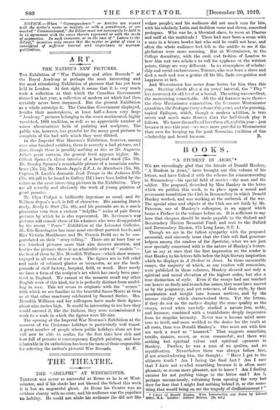ARC .
THE NATION'S NEW PICTURES.
THE Exhibition of " War Paintings and other Records " at tho Royal Academy is perhaps the most interesting and the most stimulating Exhibition of pictures that has yet been held in London. At first sight it seems that it is very much such a collection as that which the Canadian Government showed us last year, a collection of modern art which had then certainly never been surpassed. But the present Exhibition as a whole outstrips it. The Canadian Government displayed, besides their masterpieces, at least half-a-dozen very large " Academy " pictures belonging to the worst sentimental, highly varnished, 1890 tradition, as well as an appreciable number of minor abominations both of painting and sculpture. The public was, however, too grateful for the many good pictures to complain of the bad with which they were diluted.
In the Imperial War Museum's Exhibition, however, among over nine hundred exhibits, there is scarcely a bad picture, and thus, though there is possibly nothing as fine as Mr. Augustus John's great cartoon, the general level appears higher. Mr. Giibcrt Spencer's clever interior of a hospital ward (No. 70), Mr. Stanley Spencer's remarkable picture of a mountain ambu- lance (No. 75), Mr. Darsie Japp's R.F.A. in Macedonia (No. 76), Captain H. Lamb's dramatic Irish Troops in the Judaean Hills (No. SO) (all to be found in Gallery III.) have been hailed by the critics as the most interesting pictures in the Exhibition. They are all actually and obviously the work of young painters of great promise.
Mr. Glyn Thilpot is brilliantly ingenious as usual, and Sir William Orpen's work is full of character. His amusing Dutch study, Ready to Start (No. 46), and his portraits are in a much pleasanter vein than a curious " ladylike " series of pale flower pictures by which he is also represented. Mr. Nevinson's war pictures will console those of his admirers who were disappointed by his recent " Peace " Exhibition at the Leicester Galleries. Mr. Eric Kennington has some most excellent portrait heads, and Miss Victoria Monkhousc and Mr. Francis Dodd arc to be con- gratulated on their " story-telling." There are at least four or five hundred pictures more that also deserve mention, and besides the pictures there is an admirable series of " models "- the best of them by Mrs. Meredith Williams—which show women engaged in all sorts of war work. The figures are in full relief and made of coloured plaster or terracotta, as are the back- grounds of shell factory, hospital, field, or wood. Here surely we have a form of the sculptor's art which has rarely been prac- tised in England. We cannot at the moment recall any other English work of this kind, for it is perfectly distinct from model- ling in wax. This art seems to originate with the " scenes " With which we are familiar in the beautiful Sacro-Monte at Orta, or at that other sanctuary celebrated by Samuel Butler. Mrs. Meredith Williams and her colleagues have made their figures about nine inches high. It would be interesting to see how they would succeed if, like the Italians, they were commissioned to work to a scale in which the figures were life-size.
The opening of the Imperial War Museum's Exhibition at the moment of the Christmas holidays is particularly well timed. A great number of people whom public holidays alone set free will now be able to realize for the first time how rich and how full of promise is contemporary English painting, and how admirable in its catholicism has been the taste of those responsible for selecting the nation's pictorial War Records. G. P.






































 Previous page
Previous page